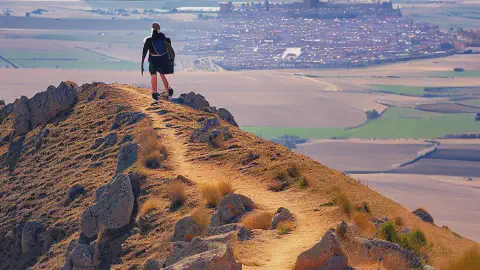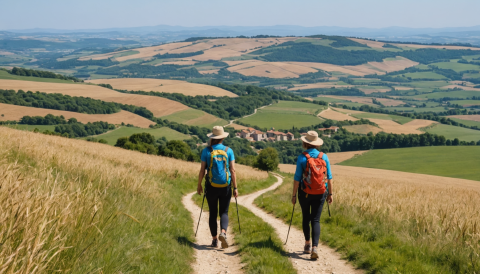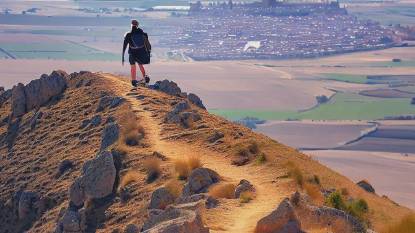
Camino Francés: Castrojeriz to Frómista - Stage 15
Posted: | Updated:
Reading time: 10 minutes
Camino Francés: Castrojeriz to Frómista - Stage 15
Posted: | Updated:
Reading time: 10 minutes
By: Simon Kemp, Editor
The Camino Francés continues from Castrojeriz, a town shaped by centuries of trade and pilgrimage, to Frómista, known for its Romanesque architecture and connection to Spain’s agricultural heartland. This section of the route crosses the Meseta, a plateau with long, open stretches and few natural obstacles.
Historical Background
- Castrojeriz: This town has been an important stop for pilgrims since medieval times. It developed around a fortress that once controlled the surrounding plains. The ruins of Castrojeriz Castle still overlook the town, and the Church of San Juan is a notable landmark with Gothic and Renaissance elements. The town’s long main street follows the Camino, making it easy for travelers to find food and lodging.
- Frómista: Known for the Church of San Martín, one of Spain’s best-preserved Romanesque churches, Frómista was a key settlement along the pilgrimage route. The town was historically linked to the Canal de Castilla, an 18th-century waterway built to improve trade and irrigation in the region.
The Camino Route
The journey from Castrojeriz to Frómista spans approximately 24.5 km and follows a well-marked dirt path through the Meseta. The route is mostly flat, but there are a few notable changes in elevation.
- Castrojeriz to Alto de Mostelares (2 km): The day begins with a climb up Alto de Mostelares, the highest point of the Meseta. The ascent is steep but short, and the view from the top stretches across the plains.
- Alto de Mostelares to Itero de la Vega (10 km): After descending from the hill, the trail crosses the Pisuerga River, marking the entrance to Palencia province. The village of Itero de la Vega offers a place to rest and refill supplies.
- Itero de la Vega to Boadilla del Camino (6.5 km): This section passes through farmland and wheat fields. Boadilla del Camino has a Templar-era church and a pilgrim fountain, making it a good stop before the final stretch.
- Boadilla del Camino to Frómista (6 km): The last part of the walk follows the Canal de Castilla, a straight path alongside the water. The canal was built in the 18th century to support agriculture and trade, and its locks and bridges are still visible today.
This stage is straightforward, with few villages and little shade, so carrying enough water is important. The climb at the beginning is the most difficult part, but after that, the terrain is easy to walk. The approach to Frómista is scenic, with the Church of San Martín standing out as a landmark before reaching the town center.
Castrojeriz to Frómista Camino Route Map
The Castrojeriz to Frómista stage of the Camino Francés is a 24.5-kilometer (15.2-mile) journey. The route begins in Castrojeriz, a village with a rich history, and involves a descent followed by a challenging climb to Alto Mostelares, providing panoramic views of the arid plains.
After crossing the Pisuerga River, you’ll reach Itero de la Vega, a rustic village known for its warm hospitality. The next segment takes you through the heart of Spain’s grain belt, featuring wide-open landscapes and golden wheat fields, until you reach Boadilla del Camino, a village with Templar history and medieval charm.
The final stretch runs alongside the Canal de Castilla, an impressive 18th-century engineering feat, leading you to Frómista, known for its stunning Church of San Martin, an exemplary Romanesque structure. The terrain is mostly flat, with the initial descent and ascent being the main challenges.
Rest stops are available in Itero de la Vega and Boadilla del Camino, while Frómista offers various amenities for pilgrims. Frómista itself is a historically significant town along the Camino de Santiago pilgrimage route, boasting architecture, cultural traditions, and natural beauty.
Previous stage: Hornillos del Camino to Castrojeriz .
Castrojeriz to Frómista Route Description
This Frómista stage of the Camino Francés is approximately 24.5 kilometers (around 15.2 miles) long.
A. Detailed Breakdown of the Route
- Castrojeriz to Itero de la Vega (12 km) Start your journey in Castrojeriz, a village teeming with history and charm. Upon leaving, you’ll face a steady descent before tackling the most significant climb of the day, the Alto Mostelares. Standing as the highest point of the Meseta, it provides a panoramic view over the arid plains, offering a perfect spot for contemplation. Continue downhill to cross the Pisuerga River, marking your entry into the Palencia province. Your destination, Itero de la Vega, is a quaint, rustic village with warm hospitality.
- Itero de la Vega to Boadilla del Camino (6.5 km) This segment features an easy stroll through the Tierra de Campos, the heart of Spain’s grain belt. Enjoy the wide-open landscapes that stretch as far as the eye can see, with golden wheat fields under the azure sky. Arrive in Boadilla del Camino, a village that boasts significant Templar history and a well-preserved medieval charm.
- Boadilla del Camino to Frómista (6 km) The final stretch of this stage runs alongside the Canal de Castilla, an impressive testament to 18th-century engineering efforts. The serene atmosphere and the gentle murmuring of the canal make for a tranquil walk. End your day in Frómista, a village renowned for the Church of San Martin, a stunning example of Romanesque architecture.
B. Terrain and Elevation
The day begins with a significant descent from Castrojeriz and a subsequent ascent to the Alto Mostelares, which can be demanding. However, the majority of the terrain is flat, with well-trodden dirt paths and minor roads. The final stretch along the Canal de Castilla provides a pleasant, flat walk into Frómista.
C. Points of Interest
- Alto Mostelares: This high point offers breathtaking panoramic views over the Meseta, a memorable sight on your Camino journey.
- Itero de la Vega: This rustic village is home to the Church of San Pedro, a Romanesque gem housing a 13th-century statue of the Virgen de la Piedra.
- Canal de Castilla: An impressive piece of 18th-century engineering, the canal stretches over 200 kilometers with charming lock gates. Walking alongside it offers a peaceful conclusion to the stage.
- Church of San Martin, Frómista: This 11th-century Romanesque church boasts intricate sculptural details and is one of Palencia’s finest examples of Romanesque architecture.
D. Potential Challenges
The main challenges on this stage are the initial descent from Castrojeriz and the ascent to the Alto Mostelares, which may strain knees and stamina. Additionally, during the summer, the open landscapes of the Meseta can bring intense heat. Ensure you have adequate sun protection and hydration.
E. Rest Stops
The villages of Itero de la Vega and Boadilla del Camino offer ideal rest stops, each with facilities for pilgrims. Frómista, the final stop, has an array of amenities, including albergues, cafes, restaurants, and a supermarket.
This stage allows you to journey through Spain’s historic grain belt, alongside an 18th-century canal, and into a village with striking Romanesque architecture. Buen camino!

Departure point: Castrojeriz
Welcome to Castrojeriz, a town in the heart of the Spanish countryside where history, natural beauty, and spirituality intertwine.
Location and History
Situated in the province of Burgos, Castrojeriz enjoys a picturesque location on a hill overlooking the expansive plains of Castilla y León. This town has a fascinating past, with archaeological evidence indicating settlements dating back to ancient times.
Architectural Marvels
Castrojeriz boasts an impressive architectural heritage that speaks volumes about its history. The Iglesia de Santa María del Manzano, a remarkable Gothic church from the 13th century, stands as a testament to the town’s religious devotion. Its intricate stone carvings and majestic spires evoke a sense of wonder.
Another notable landmark is the Castillo de Castrojeriz, a medieval fortress that once played a crucial role in protecting the town. The ruins of this castle offer glimpses into its storied past and offer breathtaking panoramic views of the surrounding countryside.
Natural Splendor
Nestled amidst rolling hills and fertile farmland, Castrojeriz enchants visitors with its natural beauty. Expansive fields adorned with vibrant wildflowers create a stunning backdrop for leisurely walks and moments of serenity. The nearby Monte de Mostelares beckons adventurers with its captivating landscapes and sweeping vistas.
Pilgrim’s Haven
As an important stop along the Camino de Santiago pilgrimage, Castrojeriz has long been a sanctuary for pilgrims on their spiritual journey. Albergues (hostels) provide pilgrims with comfortable accommodations, fostering a sense of community and camaraderie. The town’s restaurants and cafes offer nourishing meals, allowing pilgrims to recharge and share stories.
Cultural Traditions
Castrojeriz proudly celebrates its rich cultural traditions, which come alive during vibrant festivals and events. The Festival de la Cruz, held in May, fills the town with colors, music, and traditional dances, paying homage to the Christian cross and showcasing the community’s deep-rooted customs.
Gastronomic Delights
Castrojeriz entices food enthusiasts with its culinary treasures. Indulge in the succulent flavors of lechazo asado, tender roast lamb infused with aromatic herbs, or relish the robust migas, a dish made with breadcrumbs, garlic, and olive oil. Accompany your meal with a glass of renowned Ribera del Duero wine, crafted from grapes grown in the surrounding vineyards.
Destination: Frómista
Frómista is strategically situated in the province of Palencia, Spain, along the historic Camino de Santiago pilgrimage route. Its location has contributed to its history as a crucial stopping point for pilgrims on their way to Santiago de Compostela. Tracing its roots back to the Middle Ages, Frómista has witnessed the ebb and flow of travelers throughout the centuries.
Architecture: Frómista
Frómista is renowned for its extraordinary architecture that reflect its rich heritage. The Iglesia de San Martín, a splendid Romanesque church dating back to the 11th century, stands as an architectural gem. Its impressive façade, adorned with intricate sculptures and captivating details, showcases the skilled craftsmanship of the era. Inside, visitors are greeted by a magnificent interior adorned with beautiful frescoes and an awe-inspiring atmosphere.
Another striking sight is the Canal de Castilla, an impressive feat of engineering from the 18th century. This remarkable canal system was constructed to facilitate transportation of goods, connecting Frómista to the major cities of Castilla y León. The canal’s graceful waterways and picturesque locks serve as a testament to human ingenuity and provide a serene backdrop for leisurely walks and boat rides.
Cultural Heritage
Frómista takes pride in its vibrant cultural heritage, which comes to life through lively festivities and events. The Romería de la Virgen del Otero, held in September, is a cherished pilgrimage that pays homage to the town’s patron saint. Pilgrims and locals gather for processions, music, dance, and religious ceremonies, creating an atmosphere filled with reverence and celebration.
Pilgrim Services
Frómista offers a range of services and amenities to support pilgrims on their Camino de Santiago journey. The town provides comfortable albergues (hostels) where pilgrims can find rest and refreshment. For example, the Albergue El Caminante offers dormitory-style accommodations with clean facilities and a welcoming environment. The Refugio Gaucelmo, located within the Iglesia de San Martín complex, provides a unique opportunity for pilgrims to stay in a historic setting while enjoying essential amenities.
In addition to accommodations, Frómista offers pilgrims access to various services. Pilgrims can find shops and markets where they can stock up on supplies such as food, water, and basic necessities. Medical facilities and pharmacies are also available to attend to any health needs along the journey. The local tourist office provides valuable information and guidance, ensuring pilgrims have a smooth and enjoyable experience in Frómista.
Local Delicacies
Frómista delights gastronomy enthusiasts with its delectable local cuisine. One must indulge in the famous lechazo asado, succulent roasted lamb renowned for its tender meat and flavors infused with aromatic herbs. Another culinary delight is the cecina de vaca, a cured beef delicacy that captivates the palate with its rich smoky flavor and delicate texture. These traditional dishes, crafted with local ingredients, showcase the culinary heritage of the region.
Natural Surroundings
Frómista is embraced by breathtaking natural surroundings, inviting visitors to immerse themselves in the beauty of the countryside. The nearby Monte El Viejo stands as a majestic hill that offers panoramic views of the town and its picturesque landscapes. Exploring the serene trails and embracing the tranquility of nature allows visitors to connect with the essence of Frómista’s natural charm.
The next stage of the Camino Francés will take you from Frómista to Cacabelos .

